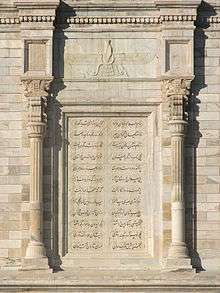Keikhosrow Shahrokh

Keikhosrow Shahrokh (Persian: کیخسرو شاهرخ) (1864 in Kerman, Iran – 1939) was the mastermind and designer of the mausoleum for Persian poet Ferdowsi at his burial site in the city of Tus.[1] As elected representative of the Zoroastrian community,[2] he was an active member of the Iranian parliament. He is best known for his role in the 1925 transition of the official calendar from the Islamic calendar of Hejri Ghamarei to the Iranian civil calendar, also known as Hejri shamsi.
Shahrokh was distantly related to Dinshah Irani, the Indian lawyer and benefactor of the Zoroastrian communities of both India and Iran. Shahrokh and Irani shared a late 18th century ancestor, most of whose children migrated to India, and from which Dinshah Irani's family descended. Shahrokh was a scion of another branch, descending from the elder son - who had remained in Iran - of that ancestor.
See also
References
- ↑ A. Shahpur Shahbazi. "Ferdowsi, Mausoleum". Encyclopaedia Iranica. Retrieved 2010-12-11.
- ↑ M. Kasheff. "Anǰoman-e Zartoštīān (Society of Zoroastrians)". Encyclopaedia Iranica. Retrieved 2010-12-11.

_-_Walters_W60276B_(cropped).jpg)
